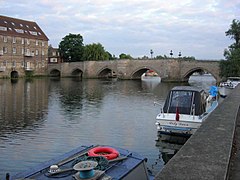Old Bridge, Huntingdon
| The Old Bridge | |
| Huntingdonshire | |
|---|---|
 The Old Bridge over the Great Ouse | |
| Location | |
| Carrying: | Ermine Street |
| Crossing: | Great Ouse |
| Location | |
| Grid reference: | TL24297147 |
| Location: | 52°19’38"N, 0°10’40"W |
| Structure | |
| History | |
| Built 1332 | |
| Information | |
The Old Bridge is a mediæval stone bridge over the River Great Ouse, connecting Huntingdon to Godmanchester in Huntingdonshire, and it is still Huntingdon's main the main town bridge.
A well-preserved bridge for its age, it bears the traffic to this day across the river on five spans supported on heavy stone pillars.
History
The town has long been an important bridgehead, with Ermine Street (connecting London to Lincoln and York), as well as various east-west trade routes, crossing the Great Ouse here. Ermine Street would have first crossed the river here by a ford, believed to be some way to the west of the present bridge.[1] King Edward the Elder built a wooden bridge in the early 10th century a few yards to the west of the current bridge, and also ordered the nearby Huntingdon Castle to be rebuilt. Until the 1107 construction of the first bridge in St Ives, it is believed that there was no bridge further downstream, and foreign trade would navigate the river as far upstream as Huntingdon.[1]
Responsibility for the bridge's repair was for centuries a matter of dispute. In 1259 a court ruling finally ordered that the county authorities should pay to keep it repaired in return for rendering the bridge toll-free. Nonetheless, the bridge remained in a poorly maintained state, and by 1329 was declared to be in severe danger of collapse.[1]
The current bridge was constructed around 1332, with work starting on both banks or the river. The slight kink near the central pier was a result of the lack of alignment of the two halves.[2] Consisting of six arches and faced with ashlar, the parapets which form recesses for pedestrians, are triangular in shape on the north side, and semi-hexagonal on the south.[1]
It was intended for both pedestrian and horse-drawn transport (the bridge has recesses for people to stand to let the heavier traffic pass), but now serves exclusively for light vehicular traffic. Pedestrians use a parallel footbridge just metres upstream, and heavy goods vehicles must use the modern bridge, which forms part of the A14 bypass.[3] However, until that was built in 1975, the narrow mediæval bridge stood alone, and had to be used by both lorries travelling the Great North Road and footgoing shoppers, to the dissatisfaction of all parties.
The bridge is now a Grade I listed structure and a Scheduled Ancient Monument.
In 2006 an entire portion of parapet was struck by traffic and plunged into the river, the repair has been done to English Heritage standard.
Outside links
| ("Wikimedia Commons" has material about Old Bridge, Huntingdon) |
References
- ↑ 1.0 1.1 1.2 1.3 @"The Borough of Huntingdon". British History. http://www.british-history.ac.uk/report.aspx?compid=42469.
- ↑ The River Great Ouse and Tributaries, (2006), Andrew Hunter Blair, Imray Laurie Norie and Wilson, ISBN 978-0-85288-943-5
- ↑ Huntingdon River Bridges